Click on images to enlarge
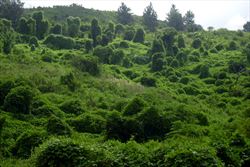
massive infestation (Photo: Forest and Kim Starr, USGS)
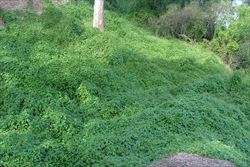
infestation (Photo: Sheldon Navie)
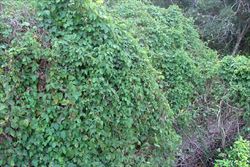
climbing habit (Photo: Sheldon Navie)
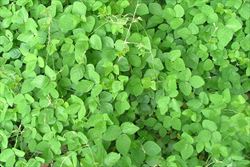
scrambling habit (Photo: Sheldon Navie)
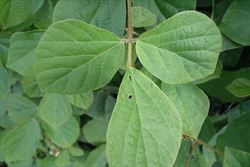
compound leaf with three leaflets (Photo: Sheldon Navie)
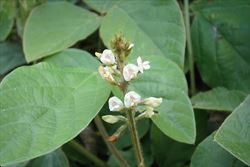
cluster of small pea-shaped flowers (Photo: Sheldon Navie)
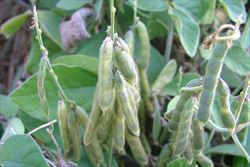
immature fruit (Photo: Sheldon Navie)
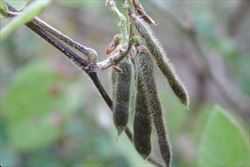
close-up of stems and mature fruit, which are covered in rusty-coloured hairs (Photo: Sheldon Navie)
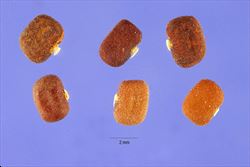
close-up of seeds (Photo: Steve Hurst at USDA PLANTS Database)

young seedling (Photo: Sheldon Navie)
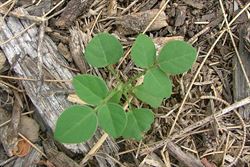
seedling (Photo: Sheldon Navie)
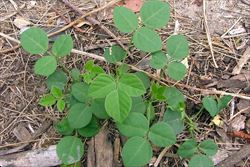
young plants (Photo: Sheldon Navie)
Scientific Name
Neonotonia wightii (Arn.) J.A. Lackey
Synonyms
Glycine javanica L.Glycine wightii (Arn.) Verdc.Notonia wightii Arn.
Family
Fabaceae (Queensland, the ACT, Victoria, Tasmania, and the Northern Territory)Fabaceae: sub-family Faboideae (New South Wales)Leguminosae (South Australia)Papilionaceae (Western Australia)
Common Names
glycine, perennial soybean, soya, Tinaroo glycine, tropical legume
Origin
This species is widespread is tropical regions and its exact origin is obscure. It is possibly native to sub-Saharan Africa (i.e. Chad, Ethiopia, Sudan, Kenya, Tanzania, Uganda, Burundi, Cameroon, Gabon, Zaire, Ghana, Guinea, Liberia, Nigeria, Sierra Leone, Togo, Angola, Malawi, Mozambique, Zambia, Zimbabwe and Botswana), Saudi Arabia, the Indian sub-continent (i.e. India and Sri Lanka) and south-eastern Asia (i.e. Indonesia and Malaysia). However, some references state that it is native to Central and South America and the Caribbean.
Cultivation
Glycine (Neonotonia wightii) has been cultivated as a pasture legume or cover crop. Several cultivars have been released in Australia for use these purposes. The four main ones being 'Tinaroo', 'Clarence', 'Cooper' and 'Malawi', with 'Tinaroo' being the most common.
Naturalised Distribution
This species is widely naturalised in the eastern parts of Australia (i.e. in coastal and sub-coastal eastern Queensland and the coastal districts of northern New South Wales).
It is possibly also naturalised on Norfolk Island and is widely naturalised in other parts of the world (e.g. French Polynesia, New Caledonia, Niue, Tonga and Hawaii).
Habitat
A common weed of waterways (i.e. riparian areas), urban bushland, rainforest margins, fences, disturbed sites, waste areas, gardens and plantation crops in wetter tropical and sub-tropical regions.
Habit
A long-lived (i.e. perennial) climbing or creeping vine that can develop a woody base. It often forms large clumps twining over fences and other vegetation.
Distinguishing Features
- a climbing plant with twining or scrambling stems up to 4.5 m long.
- its stems, leaves and fruit vary from being relatively hairless to having a dense covering of rusty velvet hairs.
- its alternately arranged leaves have three oval leaflets (1-10 cm long and 0.6-7 cm wide).
- its small white to mauve pea-shaped flowers (about 1 cm long) are borne in elongated clusters.
- its elongated pods (1.5-3.5 cm long) are turned downwards and turn dark brown or blackish when mature.
Stems and Leaves
The stems (0.6-4.5 m long) vary from being densely covered in rusty-coloured hairs (i.e. pubescent) to almost hairless (i.e. sub-glabrous). They tend to twine around themselves and other vegetation. The base of the stem becomes somewhat woody with age, while younger stems are greenish in colour.
The leaves (3-16 cm long) are alternately arranged along the stems and are borne on stalks (i.e. petioles) 2-12 cm long. They are compound with three oval (i.e. elliptic) or egg-shaped (i.e. ovate) leaflets. These leaflets (1-10 cm long and 0.6-7 cm wide) are usually velvety hairy (i.e. pubescent) on both sides, but are occasionally almost hairless (i.e. glabrous). They have entire margins and rounded to pointed tips (i.e. obtuse to acuminate apices).
Flowers and Fruit
The small flowers are arranged in elongated clusters (i.e. axillary racemes) 2-18 cm long and are borne on stalks (i.e. peduncles) 2-10 cm long. These pea-shaped flowers (about 1 cm long) are white to mauve in colour, sometimes with yellowish or purplish markings, and often turn orange as they die-off. Each flower has four or five hairy (i.e. strigose) sepals (3-8 mm long) that are fused together at the base into a short tube (i.e. calyx tube). They have a large upper petal (i.e. standard) 4-12 mm long, two side (i.e. wing) petals, and two lower petals that are fused together and folded (i.e. keel). They also have ten small stamens, nine of which are fused together, and an ovary topped with a curved style and a tiny stigma.
The small pods (1.5-3.5 cm long and 2.5-5 mm wide) are elongated in shape and somewhat flattened (i.e. compressed). They turn from green to dark brown or blackish in colour as they mature and are angled downwards (i.e. reflexed). These fruit are usually covered in rusty-coloured hairs (i.e. pubescent) and contain 4-9 seeds. The dark reddish-brown or black seeds (2.5-4 mm long and 1.5-3 mm wide) are kidney-shaped (i.e. reniform) to somewhat four-angled.
Reproduction and Dispersal
This species reproduces mainly by seed. It occasionally also reproduces vegetatively, with pieces of its older woody stems capable of taking root when they are detached.
The seeds can be spread in contaminated agricultural produce (i.e. fodder) and dumped garden waste. They may also be dispersed by water and animals.
Environmental Impact
Glycine (Neonotonia wightii) is regarded as an environmental weed in Queensland and northern New South Wales. It is also seen as a potential environmental weed or "sleeper weed" in other parts of northern Australia. This species can infest extensive areas of open land and rainforest margins where it smothers grasses and other understorey vegetation, and sometimes even shrubs and smaller trees. It reduces the amount of light reaching these plants, eventually even killing them, and prevents the regeneration of native species. Its growth is most prolific in tropical and sub-tropical climates where the annual rainfall is between 750-1500 mm.
Glycine (Neonotonia wightii) is currently of most concern in south-eastern Queensland, and during a recent study it was ranked among the top 20 most invasive environmental weeds in this region. It appears on numerous local environmental weed lists in south-eastern Queensland (i.e. in Ipswich City, Gold Coast City, Maroochy Shire, Beaudesert Shire, Cooloola Shire and Redland Shire) and is regarded as a threat to ecosystem integrity in conservation areas in Springbrook, on the Gold Coast hinterland.
Glycine (Neonotonia wightii) is also listed as an environmental weed in the Townsville City Council region and as an undesirable plant in the Wet Tropics World Heritage Area in northern Queensland. In New South Wales, glycine (Neonotonia wightii) is sporadically naturalised in coastal districts, mainly north from the Bellingen area.
Legislation
Not declared or considered noxious by any state government authorities.
Management
For information on the management of this species see the following resources:
- the Biosecurity Queensland Fact Sheet on this species, which is available online at http://www.dpi.qld.gov.au.
Similar Species
Glycine (Neonotonia wightii) can be confused with the native rhynchosia (Rhynchosia minima). These two species can be distinguished by the following differences:
- glycine (Neonotonia wightii) has white or mauve coloured flowers that turn orange in colour when they die off. Its pods are elongated in shape (15-36 mm long), contain several (4-7) seeds, and are usually covered in obvious rusty-coloured (i.e. ferruginous) hairs.
- rhynchosia (Rhynchosia minima) has yellow flowers with reddish-coloured markings. Its pods are relatively short (10-15 mm long), contain only a few (1-3) seeds, and are covered in short fine hairs (i.e. puberulent).

